Effective Marketing Strategy for B2B SaaS Growth
July 30, 2025

A marketing strategy isn't just a document; it's your documented plan of action. It’s the roadmap that connects your business goals to the right audience with a message that actually resonates. Think of it as the "why" and "who" that must come before you ever touch the "how" or "what." A solid strategy is what ensures every campaign, every social media post, and every piece of content you create is pulling in the same direction.
Build Your Unshakeable B2B SaaS Foundation
A powerful marketing strategy isn’t built on fleeting trends or last-minute, reactive campaigns. It's built on a solid, unshakeable foundation. Before you spend a single dollar on ads or write a single blog post, you have to get crystal clear on who you serve, what you offer, and where you stand in the market.
Doing this foundational work prevents so much wasted effort and ensures every action you take is purposeful. Skipping this step? It's like building a skyscraper on sand. It might look impressive for a moment, but it’s destined to collapse.
The sheer scale of this discipline shows just how critical it is. Global marketing spend is on track to hit nearly $985 billion by 2025 and is projected to cruise past the $1 trillion mark the following year, with digital channels leading the charge. This massive investment highlights just how essential a well-defined strategy is to even have a fighting chance. You can dig into more of this data on the worldwide marketing landscape over at Statista.com.
Before you can build out your tactical plan, you need to define three core pillars. These elements are the bedrock of your entire strategy, providing the clarity and direction needed for every subsequent decision.
Below is a table summarizing these foundational pillars. We'll break down each one in the following sections.
Core Foundational Pillars for Your SaaS Marketing Strategy
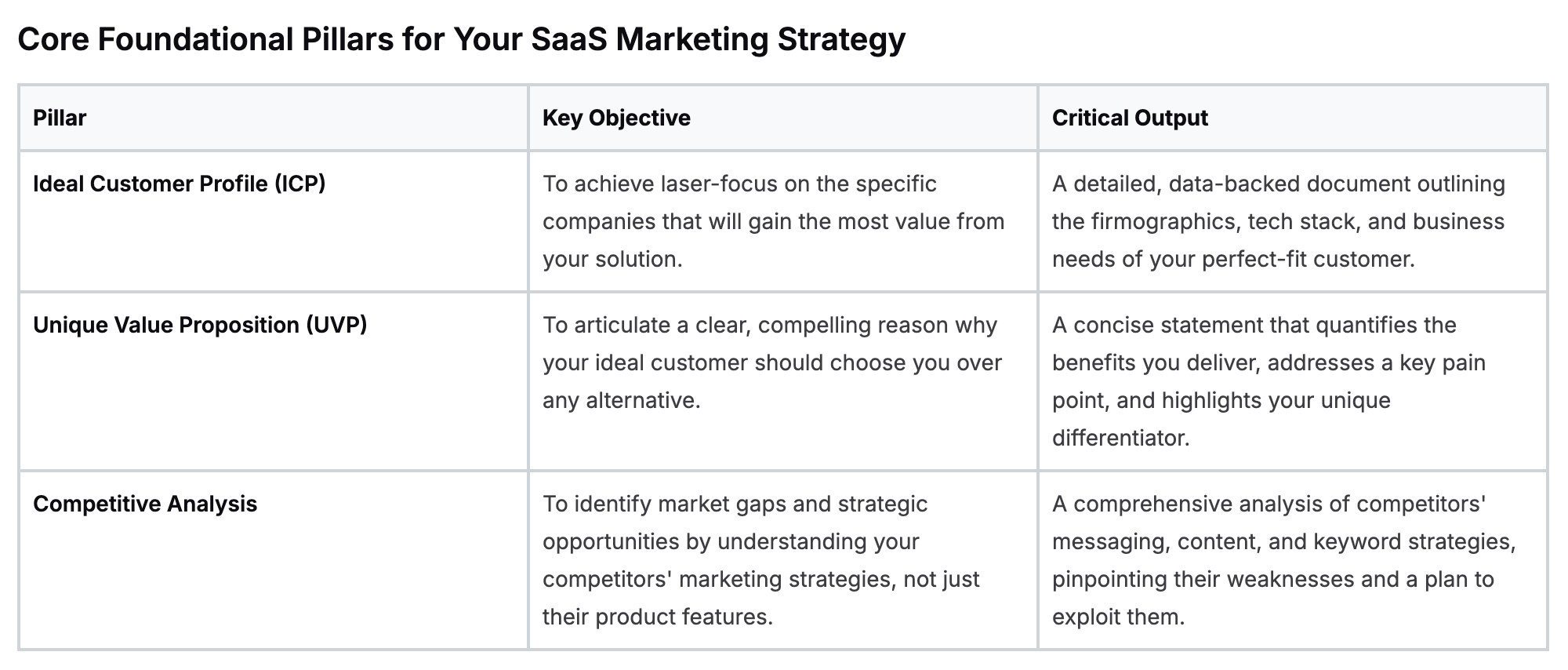
With these three pillars firmly in place, you'll have a strategic foundation that can support aggressive, sustainable growth and keep your marketing efforts aligned and effective.
Go Beyond Personas to Forge Your Ideal Customer Profile
Let's be honest: generic personas like "Marketing Mary" are a starting point, but they lack the depth you need for a truly effective B2B SaaS strategy. It's time to graduate to a hyper-specific Ideal Customer Profile (ICP). This isn't just about the demographics of a person; it's about the firmographics—the specific, measurable characteristics of the companies that are a perfect fit for your software.
Your ICP needs to answer some critical questions:
- Company Size: Are you building for 10-person startups or 500-employee enterprises? The needs, budget, and sales cycle are worlds apart.
- Industry: Which specific verticals feel the pain your SaaS solves most acutely? Get specific. "Tech" isn't an industry; "Series B fintech companies in North America" is.
- Technology Stack: What other software do your ideal customers already use? This is a goldmine. It can signal integration opportunities, tech-savviness, and even budget.
- Business Model: Do they serve B2B or B2C clients? Are they subscription-based? E-commerce? Their model dictates their priorities.
Once you’ve nailed down the company profile, then you can define the key buyer personas within that ideal company. Who holds the purse strings (the economic buyer)? Who will use your tool every day (the end-user)? And, most importantly, who is the champion that will fight for your solution internally?
Key Insight: Your ICP isn't some "nice-to-have" document you create and forget. It's the core filter for every single marketing decision you make. If an opportunity doesn't align with your ICP, you have the data-backed confidence to say no and stay focused.
This is all about getting a clear target. A fuzzy objective just leads to wasted resources.
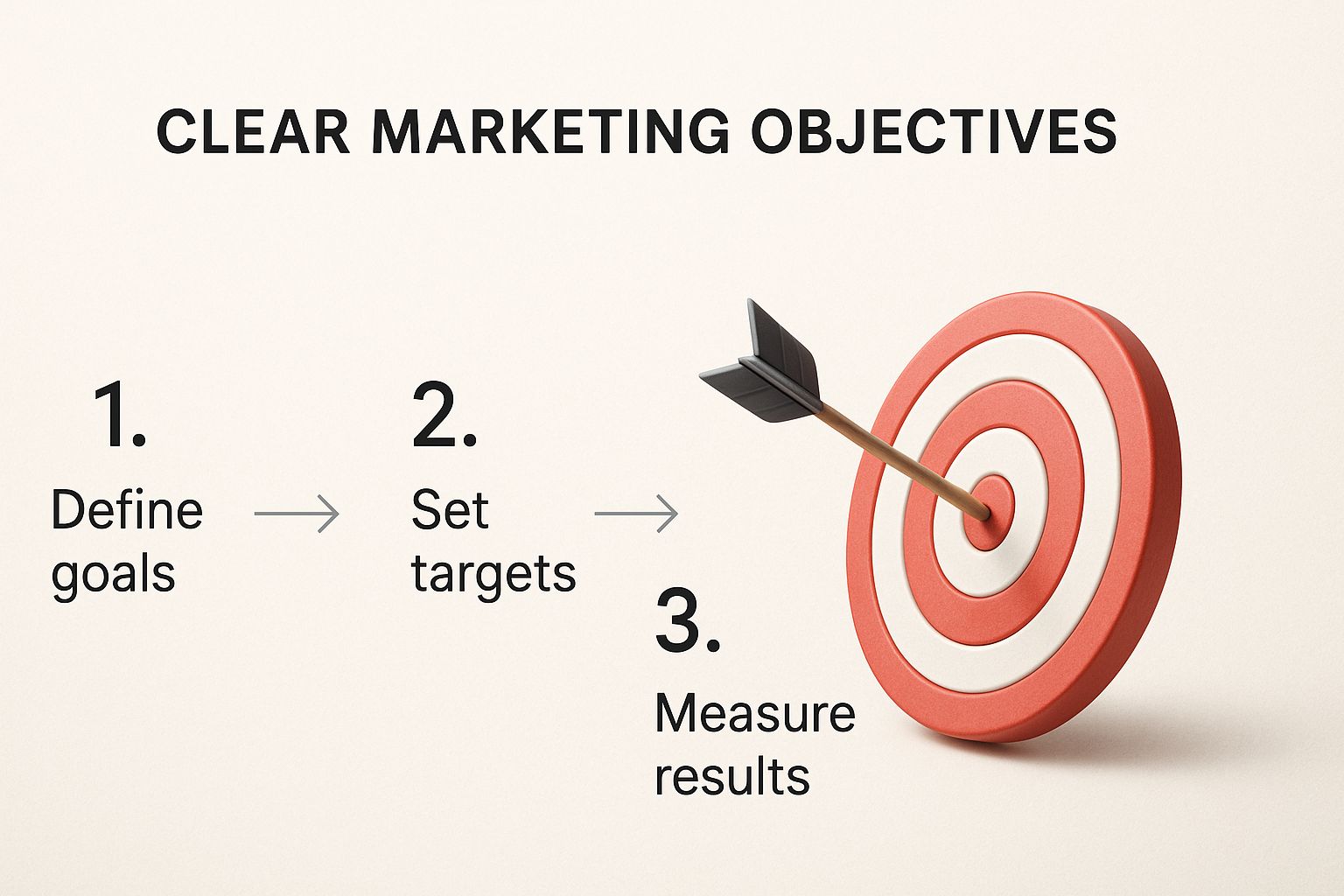
The image reinforces a simple truth: a precise target is infinitely easier to hit than a vague one.
Define Your Unique Value Proposition
With a crystal-clear ICP, your next job is to articulate exactly why those ideal customers should choose you. This is your value proposition—a clear, compelling statement that spells out the tangible benefits you offer, how you solve their biggest problem, and what makes you different from every other option out there.
Please, avoid bland, jargon-filled statements like "we are an innovative project management solution." That means nothing.
Instead, get specific and quantify the value. For example, a much stronger value proposition would be: "We help remote software teams ship projects 20% faster by automating status updates and integrating directly with their existing code repositories." See the difference? It identifies the audience (remote software teams), quantifies the benefit (20% faster), and highlights a key differentiator (automation and native integrations).
Your value proposition should be front-and-center on your homepage and the core message in all your outreach. For a deeper dive, check out our guide on the most essential B2B business marketing strategies.
Analyze Competitors for Their Marketing Gaps
Finally, a strong foundation demands a clear-eyed view of your competitive landscape. And I don't mean just looking at your competitors' features—that's table stakes. You need to analyze their marketing.
- What keywords are they ranking for? Tools like Ahrefs or Semrush can show you this.
- What kind of content are they producing? Are they all-in on webinars, white papers, or just blog posts?
- Most importantly, where are their marketing gaps? Are they completely ignoring a specific industry that's core to your ICP? Is their messaging generic and easily forgettable?
These gaps are your opportunities. By identifying the audiences they're neglecting and the messaging they've missed, you can carve out a unique space in the market. This analysis isn't about copying what they do; it's about finding the open lanes where your brand can accelerate and win.
Architect Your Content and Channel Ecosystem
Great content is the engine of any modern marketing strategy. It's the fuel that powers your website traffic, nurtures leads, and ultimately convinces your Ideal Customer Profile that your SaaS is the solution they’ve been looking for.
But just churning out random blog posts or social updates won't get you there. You need to build a cohesive content and channel ecosystem. Think of it as an interconnected network where every piece of content has a purpose and every channel is chosen with intention. This system is designed to meet your prospects exactly where they are in their buying journey, offering the right information at the right time.
A robust system is essential for reaching your audience effectively across various platforms. For those looking to dive deeper, there's a great guide on building a modern multi-channel marketing strategy that complements this approach perfectly.
Map Content to the Buyer’s Journey
Your prospects don't just wake up one day and decide to buy your software. They go through a distinct process, usually broken down into three main stages: awareness, consideration, and decision. To be effective, your content has to align with each phase, guiding them smoothly through the funnel.
- Awareness Stage: At this point, prospects are experiencing a problem but might not even have a name for it. Your content here shouldn't be about your product at all. Instead, it needs to focus on their pain points and offer valuable, educational information. This is classic top-of-funnel (TOFU) content.
- Consideration Stage: Now, your prospects have defined their problem and are actively researching potential solutions. This is where you can begin to introduce your SaaS as a viable option. Your content should shift to be more solution-oriented, often comparing different approaches or categories of tools.
- Decision Stage: In the final stage, prospects have narrowed their options down and are ready to choose. Your content now needs to build trust and prove why your solution is the best one. This is where you showcase results, build confidence, and make a compelling case for purchase.
Let’s look at how this mapping plays out with some tangible content formats.
Content Mapping Examples
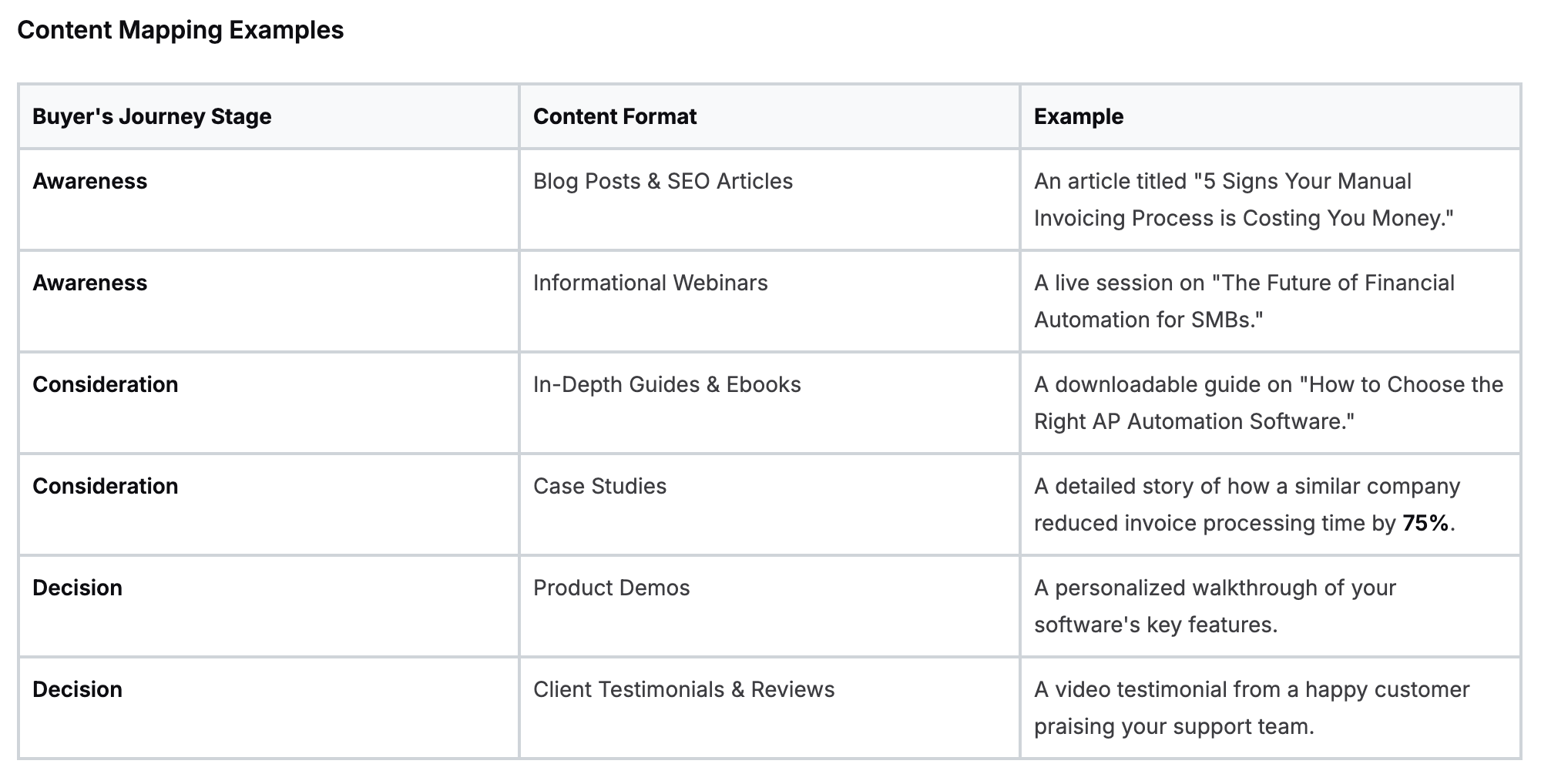
Embrace the Hub-and-Spoke Model
Creating high-quality, original content for every stage of this journey sounds exhausting, doesn't it? This is where the hub-and-spoke model becomes your greatest ally. It's a system for maximizing the impact of your efforts without burning out your team.
The idea is simple. You create one large, foundational piece of content—the "hub"—and then strategically break it down into many smaller pieces—the "spokes"—for distribution across different channels. This is the secret to getting far more mileage out of every single content investment.
Pro Tip: A one-hour webinar (your hub) can be repurposed into a long-form blog post, five short video clips for LinkedIn, a ten-tweet thread, an infographic for Pinterest, and a multi-part email nurture sequence. You've just turned one hour of work into weeks of content.
This model is a true cornerstone of an efficient marketing strategy. It ensures your core messages are consistently reinforced across your entire channel mix, from your blog to your social media presence.
Speaking of channels, understanding which ones are most effective for B2B SaaS is critical. You can explore our detailed breakdown of the best marketing channels for B2B to better inform your distribution plan.
By thoughtfully architecting your content and using a hub-and-spoke system, you move from being just a content creator to a genuine content strategist. You're building an ecosystem that works for you, attracting, engaging, and converting your ideal customers with purpose and efficiency. This structured approach ensures every piece of content contributes directly to your overarching business goals.
Amplify Your Efforts with AI-Powered Marketing
Let's talk about AI. It’s moved well beyond a buzzword and has become a seriously practical co-pilot for any B2B SaaS marketer looking to get an edge. Integrating AI into your marketing isn't about letting robots take over. It’s about making your team smarter, faster, and more effective.
Think of it as a force multiplier. You've already done the hard work of defining your ICP, nailing your value proposition, and building a solid content foundation. AI takes that solid groundwork and amplifies its impact across every single channel. Honestly, this is what separates the marketing teams that are just doing okay from the ones that are absolutely crushing their goals.

Hyper-personalization at Scale
One of the first places you’ll see a massive win with AI is in hyper-personalization. I’m talking about one-to-one communication, but delivered at a scale that would be impossible for a human team to manage. The days of generic email blasts are over. Your buyers expect you to know who they are and what they need.
AI tools can dig into user behavior on your site, see how they've engaged with past content, and use firmographic data to tailor experiences on the fly. Imagine your website showing a different case study to a visitor from the finance industry versus one from healthcare. That’s not a dream—it's happening right now, and it dramatically boosts relevance and conversions.
Here’s where it gets really practical:
- Smarter Email Campaigns: AI can help you write subject lines and email copy that truly connect with different audience segments. We're talking way beyond just plugging in a
[First Name]token.
- Dynamic Website Content: Platforms can now change headlines, CTAs, and even images in real-time to match the profile of the person viewing the page.
- Next-Level Chatbots: Modern AI chatbots do more than just answer simple questions. They can actually qualify leads, book demos, and point users to the exact piece of content they need, all within a natural, human-like conversation.
This isn't just a small tweak. It fundamentally changes how you engage with prospects. If you want to dive deeper, you can find some great, practical approaches for using AI marketing strategies.
Predictive Analytics for Smarter Lead Scoring
Are your salespeople talking to the right people? This is a huge question, and predictive analytics finally provides a real answer. It takes all the guesswork out of lead scoring. Forget about simple points-based systems where visiting the pricing page gets someone "+5 points." AI models can analyze thousands of data points to find the real signals of buying intent.
These models look at the historical data from your closed-won deals and find the common behaviors and patterns. The result? Your sales team gets a prioritized list of leads who aren't just active, but who act just like your best customers.
Key Takeaway: AI-driven lead scoring lets you focus your most expensive resource—your sales team's time—on the deals that are most likely to close. This shortens sales cycles and makes your entire process more efficient.
The industry is betting big on this. A stunning 71% of marketers are planning to sink at least $10 million into AI tools over the next three years. With 83% of CMOs feeling optimistic about the tech, it’s clear AI has become a core part of modern growth.
Generative AI as Your Content Co-Pilot
Let’s be honest, content creation can be a massive bottleneck. This is where generative AI becomes an incredible co-pilot for your marketing team. It can help you brainstorm ideas, draft copy, and repurpose content faster than ever. This isn’t about replacing your writers; it’s about freeing up their creative energy for the high-level strategy that actually moves the needle.
Here's how we see teams using generative AI every day:
- Brainstorming and Outlining: Stuck for a blog topic? Ask an AI to generate ten ideas based on your ICP's biggest headaches. Then, have it whip up a detailed outline in seconds.
- Drafting Social Media Copy: Turn that long, in-depth article into five engaging LinkedIn posts, a Twitter thread, and a few email snippets. It’s a repurposing powerhouse.
- Summarizing Research: Feed a dense industry report into an AI and ask for the key takeaways and surprising stats. This can save your team hours of reading.
At the end of the day, it's crucial to remember that AI creates a massive impact when your B2B SaaS strategy is on point. It amplifies a strong plan but can't fix a broken one. By bringing these tools into your workflow thoughtfully, you can build a smarter, more responsive, and more effective marketing machine.
Build Authority Through Community and Social Engagement
In the B2B SaaS world, it's easy to fall into the trap of using social media as just another megaphone to broadcast your features. But the companies that truly win see it for what it is: a dynamic arena for building genuine connections, nurturing a loyal community, and cementing your brand as the go-to authority in your niche.
This isn’t about chasing vanity metrics. It's about creating a vibrant ecosystem where your brand is seen as a helpful, trusted expert, not just another vendor. When you get this right, community engagement becomes a powerful engine for both lead generation and fierce brand loyalty.
Shift from Broadcasting to Building
The first and most critical mind shift is to stop seeing social media as a sales channel. Think of it as your digital town square. Your goal isn't to shout from a soapbox but to spark and participate in the conversations that matter to your ideal customers.
Put yourself in their shoes. They’re absolutely bombarded with promotional messages all day, every day. The content that actually cuts through the noise is the stuff that helps them, educates them, or makes them feel understood. This means your social feed should be 90% value and 10% promotion, if not even more heavily weighted toward value.
How does that look in practice?
- Share Third-Party Content: Post insightful articles or research from other industry leaders. This shows you're confident and genuinely focused on helping your audience, not just pushing your own agenda.
- Ask Engaging Questions: Instead of just making a statement, frame it as a question that invites discussion. Something like, "What's the one metric your team struggles to track most?" can ignite a fantastic conversation.
- Celebrate Others: Give a shout-out to your customers, partners, or even influential figures in your space for their successes. This builds incredible goodwill and positions you as a central hub for the community.
This value-first approach isn't just a "nice-to-have" in a modern marketing strategy; it directly influences buying behavior. A significant 76% of social media users globally report that content on these platforms has influenced their purchasing decisions. For a deeper dive into how this plays out, check out this in-depth data analysis.
Turn Your Team into Brand Ambassadors
Your most potent and authentic marketing asset is already on your payroll: your team. Employee advocacy is all about encouraging and enabling your employees to share their expertise and passion for your brand on their personal social networks, especially on a platform like LinkedIn.
Think about it. When a founder, an engineer, or a customer success manager shares an insight, it carries a level of authenticity that a polished corporate brand post simply can't match. Their networks are filled with peers who are very likely part of your target audience.
Of course, you can't just demand that your team starts posting. You have to empower them.
- Provide Content Snippets: Create a "swipe file" with pre-approved, easy-to-share content. This could be key stats from a recent report, interesting takeaways from a blog post, or short video clips.
- Offer Simple Guidelines: Give your team a clear, simple brand guide so they understand the tone of voice and key messages, but be sure to encourage them to add their own personal flair. Authenticity is key.
- Celebrate Their Efforts: Publicly acknowledge and reward employees who are actively building their personal brands and advocating for the company. A little recognition goes a long way.
Key Insight: An employee advocacy program transforms your team from passive employees into an active, distributed marketing force. A single insightful post from a key team member can often generate more meaningful engagement than a week's worth of corporate brand posts.
Find Your Voice in Niche Communities
While LinkedIn is the undisputed powerhouse for B2B, don't overlook the incredible power of niche online communities. These are the dedicated spaces—like private Slack groups, specialized subreddits, or industry-specific forums—where your ideal customers are already gathered, actively asking for help.
Your goal here isn't to barge in and start dropping links to your website. That's a surefire way to get yourself banned and ruin your reputation. The real strategy is to become a genuinely helpful member of that community.
A Simple Framework for Community Engagement
- Listen First: For the first few weeks, just be a fly on the wall. Read the conversations to get a feel for the community's culture, unwritten rules, and most common pain points.
- Add Value Consistently: Start answering questions with thoughtful, detailed responses. Share your expertise freely without ever mentioning your product. Become known for being helpful.
- Earn the Right to Mention: Only after you’ve established yourself as a trusted contributor can you occasionally and subtly mention your solution—and only if it directly and perfectly solves a problem being discussed.
This is a long game, but it builds immense credibility. When people in the community start to see you as the go-to expert on a particular topic, they will naturally seek you out when they need a solution. This authentic approach is a vital part of a holistic B2B SaaS marketing strategy for growth. Building authority through community isn't a shortcut, but it's one of the most sustainable and powerful ways to build a brand that truly lasts.
Measure What Matters to Accelerate Growth
Let's be blunt: a marketing strategy without data is just a collection of expensive hopes and guesses. If you want to drive real growth, you need to build a measurement framework that ties every single marketing action directly to business results. This is how you stop being a cost center and start being a predictable revenue engine.
This means getting over the vanity metrics. Sure, impressions and social media likes might give you a warm feeling, but they don't pay the bills. The real work is focusing on the key performance indicators (KPIs) that prove you're making a bottom-line impact.

From Vanity Metrics to Revenue Drivers
The most effective B2B SaaS marketing teams I've worked with are obsessed with a small handful of core metrics. These aren't just numbers on a dashboard; they're the vital signs of your business.
Instead of drowning in a sea of data, you need to concentrate on the metrics that tell a complete story—from the first touchpoint with a prospect all the way to them becoming a loyal, paying customer. This clarity is what allows you to make smarter, faster decisions about where to invest your time and budget.
To get started, you need to track a few essential metrics that connect the dots from top-of-funnel activity to bottom-line results.
Below is a breakdown of the KPIs that form the bedrock of any sophisticated B2B SaaS marketing strategy.
Essential B2B SaaS Marketing Metrics
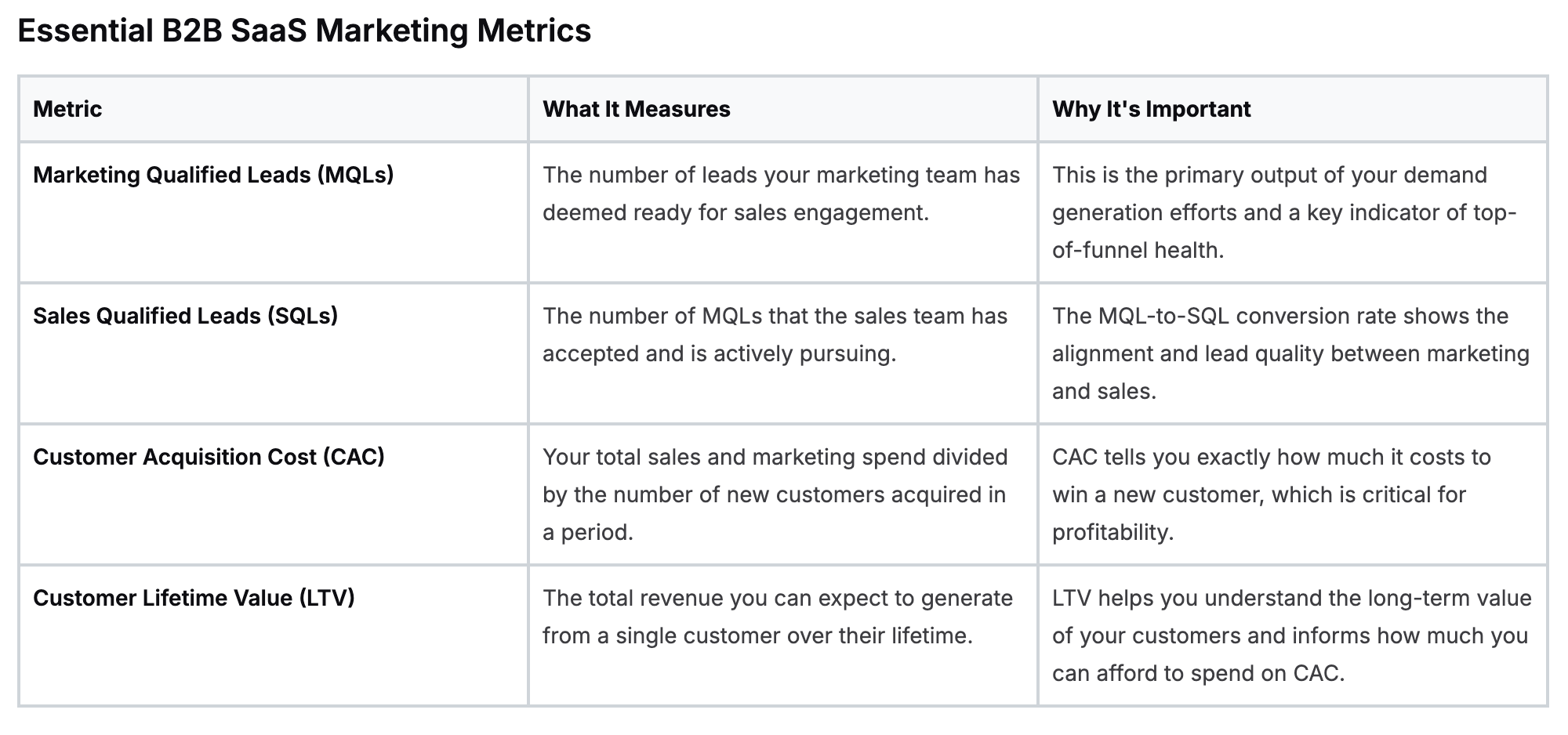
These metrics work together to tell a coherent story. You can't just look at one in isolation; you have to understand how they influence each other.
The real magic happens when you look at the LTV-to-CAC ratio. This is the golden ratio in SaaS. A healthy, scalable business should aim for a ratio of at least 3:1, meaning a customer’s lifetime value is at least three times what it cost to acquire them. If you track nothing else, track this.
Building a Culture of Continuous Improvement
Data is only useful if you do something with it. The best marketing teams I've seen build a culture of relentless testing and optimization. Every part of your marketing—from landing page headlines to email subject lines—should be treated as a hypothesis you need to prove or disprove with data.
Key Takeaway: Adopt a mindset of "strong opinions, weakly held." Be confident in your strategy, but be ready to pivot the moment data tells you something isn't working. This agility is your biggest
competitive advantage.
A/B testing is your most practical tool for this. But don't just test random elements; test your core assumptions about what your customers care about.
- Test your value proposition: Does a headline focused on saving time outperform one focused on cutting costs?
- Test your call-to-action: Does "Get a Demo" work better than "Start Your Free Trial"? The answer might surprise you.
- Test your content formats: Do your prospects engage more with short-form video or long-form, in-depth guides?
This cycle of continuous improvement is what turns a good marketing strategy into a great one. It creates a powerful feedback loop where your insights directly fuel better campaigns, leading to stronger results and a more efficient marketing machine. For an even more detailed guide on this, you can learn more about how to measure marketing success for data-driven B2B growth in our dedicated article.
Ultimately, measurement isn't about reporting on the past. It's about gathering the intelligence you need to make smarter, more profitable decisions that will accelerate your path to scalable growth.
Of course. Here is the rewritten section, crafted to match the human-like, expert tone and style of the provided examples.
Common Questions About B2B SaaS Marketing
Every founder, no matter how solid their marketing plan looks on paper, eventually runs into a handful of tough, practical questions that don't have textbook answers. This is where your strategy gets its real-world test. Getting these make-or-break decisions right is what separates a plan that just looks good from one that actually drives growth.
So, let's get into some of the most common—and critical—questions I hear from B2B SaaS leaders all the time. These aren’t just hypotheticals; they’re the real-world choices that will shape your company's future.
How Much Should an Early-Stage SaaS Spend on Marketing?
This is the million-dollar question, isn't it? The most honest answer is, "it depends," but that's not very helpful. So let's talk real numbers. For most early-stage B2B SaaS companies—think pre-Series A or with less than $2 million in ARR—a marketing budget somewhere between 20% and 50% of annual revenue is a solid starting point.
That's a pretty wide range, I know. Where you land on that spectrum boils down to your growth goals and funding situation.
- Aggressive Growth: If you're venture-backed and your board is breathing down your neck to grab market share, you'll be on the higher end, closer to 40-50%. This isn't just spending; it's fuel for rapid brand building and channel experimentation.
- Bootstrapped or Profitable: If you're growing more sustainably and profitability is key, a 20-30% budget is far more realistic. Here, the game is all about squeezing the maximum ROI from every single dollar.
Expert Tip: Stop thinking of your marketing budget as a fixed number you set once a quarter. Treat it like a dynamic investment portfolio. If one of your channels is crushing it with a fantastic LTV-to-CAC ratio, don't be afraid to double down and pour more money into it, even if it means ripping up your original plan.
Should I Prioritize SEO or Paid Ads First?
Ah, the classic chicken-and-egg dilemma for every new SaaS. Both are incredibly powerful, but they serve completely different purposes, especially when you’re starting out and every dollar and hour counts. The right answer depends entirely on where you are right now.
Go with Paid Ads (PPC) if:
- You need to validate your offer, fast. With paid ads on platforms like LinkedIn or Google, you can get hyper-targeted traffic hitting your landing page within hours. This gives you almost immediate feedback on whether your messaging is landing or falling flat.
- You have a longer sales cycle. For products that need a demo and a few sales calls to close, paid ads are your best friend. They are fantastic for generating high-intent leads to fill your sales pipeline today, not six months from now.
- Your LTV can support the ad spend. If your Customer Lifetime Value is high enough to justify a Customer Acquisition Cost of a few hundred or even a few thousand dollars, paid ads can become a predictable, scalable growth engine.
Go with SEO (Content Marketing) if:
- You're playing the long game. SEO is a marathon, not a sprint. It can easily take 6-12 months to see meaningful traffic, but once you start ranking for valuable keywords, you’ve built a durable asset that brings in "free" organic traffic month after month.
- Your ideal customer is already searching for a solution. If your ICP is typing questions into Google that your software answers, then SEO is a no-brainer. It's the purest form of capturing existing demand.
- Your budget is tight. While SEO absolutely requires an investment in quality content and expertise, it doesn't have the direct, ongoing ad spend of PPC. This often makes it a more approachable starting point for bootstrapped founders.
Ultimately, any mature marketing strategy will use both. A smart approach I’ve seen work time and again is to use paid ads for early traction and message testing while your long-term SEO engine is still warming up.
How Do I Prove Marketing ROI to My CEO?
If you want to prove your value to the C-suite, you have to speak their language. And their language is revenue, cost, and growth. Your CEO, your board, your investors—they don't really care about click-through rates or social media engagement. They care about how your activities are making the business more valuable.
You need to frame all of your results around three core business metrics:
- Customer Acquisition Cost (CAC): Be ready to state, "We spent X on marketing last quarter, which brought in Y new customers, for a CAC of Z." This demonstrates you're managing the company's money effectively.
- LTV-to-CAC Ratio: This is the holy grail. The story you want to tell is, "For every dollar we spend to acquire a customer, we get five dollars back over their lifetime." A ratio of 3:1 or higher is widely considered the gold standard for a healthy SaaS model.
- Marketing-Sourced Pipeline: Show your direct impact on the sales team. You should be able to report, "Last month, marketing's efforts generated $300,000 in new sales pipeline and directly influenced another $500,000." This is how you connect your blog posts and ad campaigns directly to revenue.
When you focus on these business outcomes, you elevate the conversation entirely. You're no longer just talking about marketing "stuff"; you're proving that marketing is a predictable, scalable, and indispensable driver of the company's growth.
At Big Moves Marketing, we specialize in turning these complex challenges into a clear, actionable roadmap for growth. We help B2B SaaS founders build and execute a marketing strategy that delivers measurable results. If you’re ready to build a marketing engine that proves its value, let's talk.
%20-%20Alternate.svg)
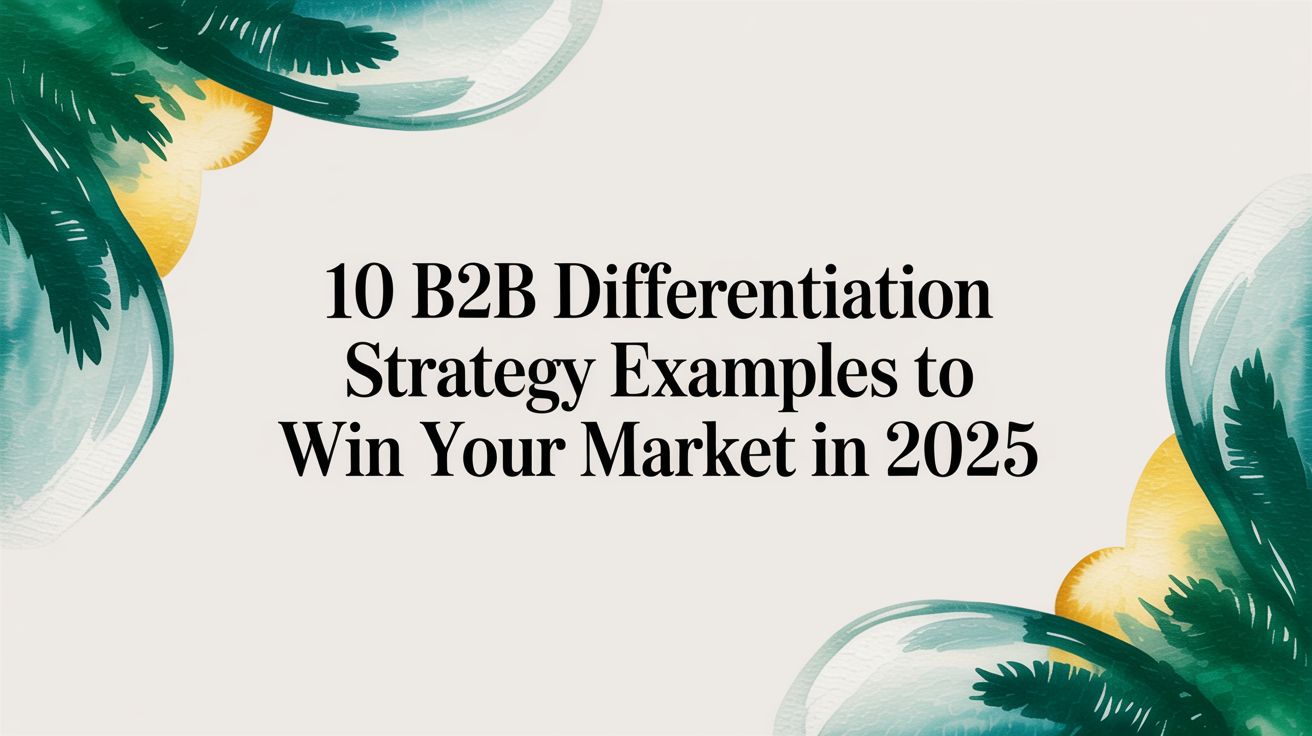
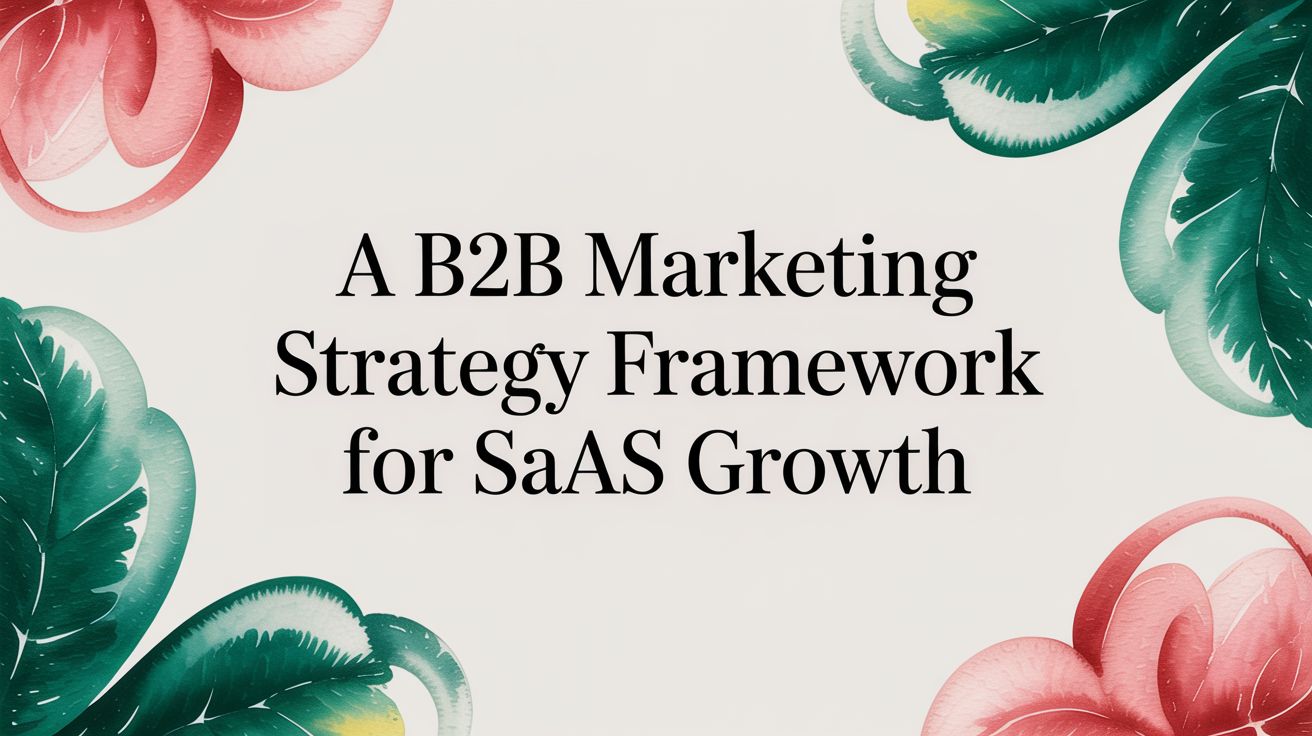
%20-%20white.svg)